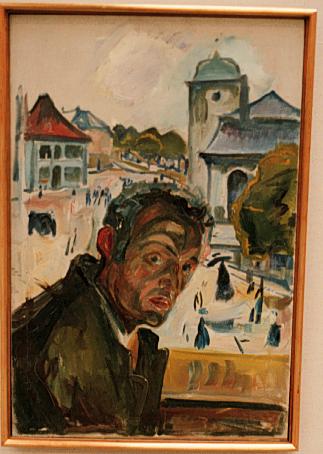Description
The painting "Self -portrait in Bergen" by Edvard Munch, created in 1916, offers a deep introspection in the psyche of the Norwegian artist, a master of symbolism and modernism. Known for his overwhelming emotionality and his exploration of human anguish, Munch uses this work as a mirror that reflects not only its exterior, but also the internal struggles that marked his life.
When observing the composition, the portrait is characterized by an intense and almost disturbing look that confronts the viewer. Munch introduces himself in the foreground, with a hacking background that, far from being merely decorative, adds an oppressive and melancholic atmosphere sensation. The choice of a faint background allows the viewer to focus on his face, which is the window to his soul; The color palette is bleak, dominated by dark tones that evoke sensations of sadness and reflection. The blue, brown and black predominate, while the warmer tones that could have provided emotional relief are almost non -existent, suggesting a constant struggle with their emotions.
Munch's style in this work is recognizable by the way he uses undulating lines and a free brushstroke that seems to capture the essence of the moment more than a mere literal portrait. The characterization of his face, with his angular factions and an expression that oscillates between contemplation and suffering, is an authentic representation of existential anguish that Munch approached throughout his career. His penetrating look can be interpreted as a question to the human condition; a recognition of the tribulations of the soul.
Although it is a self -portrait, the figure of the artist also evokes the feeling of being trapped in a cruel and chaotic world. Munch, who lived the tragedy of losing his mother at an early age and experienced mental health problems, manages to capture in this work a connection between his inner light and the gloom of the surrounding environment. His art is a reflection of his own life, touching universal issues such as loneliness, despair and the search for meaning.
The "self -portrait in Bergen" is at a time when Munch continued to develop his unique style, influenced by the symbolism and modernist aesthetics that flourished in Europe. This period of his life was marked by the search for a visual language that could express not only his own experience, but also the anxieties of a society that faced deep changes. In this context, painting becomes more than a simple portrait; It becomes a testimony of its creator's artistic and emotional struggle.
The work can be related to other works of its extensive career, where the human figure is presented as a vehicle to explore suffering and passion, as observed in its other emblematic creations such as "the cry" or "the Madonna". Through "Self -portrait in Bergen", Munch continues his exploration of the self, a trip that leads him to confront not only his image, but the anguish that accompanied his life and art.
In short, "Self -portrait in Bergen" is more than a self -portrait; It is a fundamental piece that reveals the deep connection between the individual and his emotional context, a testimony of the vast spectrum of human suffering through the eyes of an artist who never stopped investigating the complexity of existence.
KUADROS ©, a famous paint on your wall.
Hand-made oil painting reproductions, with the quality of professional artists and the distinctive seal of KUADROS ©.
Art reproduction service with satisfaction guarantee. If you are not completely satisfied with the replica of your painting, we refund your money 100%.

